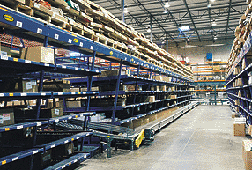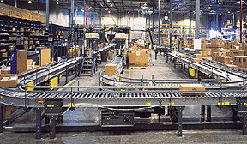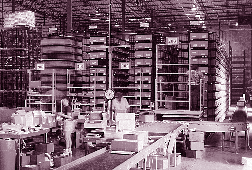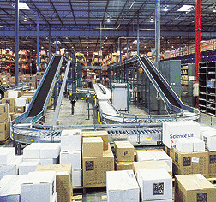McGraw-Hill Handles 30% Increase in Business, Reduces Necessary Manpower with Cisco-Eagle System
"We are adding maybe 15 temporaries instead of 50 and the permanent crew was probably reduced by 5 or 6 people. There is a considerable labor savings."
Ask Our Experts!
Customer:
McGraw-Hill
Application:
Publishing distribution center
SIC code:5192
The situation:
Anticipating an imminent 30% increase in sales, McGraw-Hill Companies resolved to upgrade its national distribution center to handle the increased volume. To meet the anticipated demand, McGraw hired Cisco-Eagle to implement an upgraded order picking system.
The impact:
With the previous system, most orders were manually picked from shelves. The result: extra steps and picking time for order pickers.
Says McGraw-Hill’s Gerald McGuriman: "I did an analysis on the projected 30% increase in volume before we decided to spend the money. I determined that had we not done something out there I would have needed 99 permanent people and almost 150 temporaries."
The desired solution:
 McGraw-Hill had to be able to continue its high level of service despite the new influx of business. Through analysis, the company determined that the system payback should be no more than two years. "Two years was important," McGuriman said. "But I know I will be able to get my production out and that is the key."
McGraw-Hill had to be able to continue its high level of service despite the new influx of business. Through analysis, the company determined that the system payback should be no more than two years. "Two years was important," McGuriman said. "But I know I will be able to get my production out and that is the key."
McGraw-Hill needed to keep shipping books during the installation of the new material handling system, so the installation was timed to happen during the company’s slow season. McGraw-Hill and Cisco-Eagle worked hand-in-hand to install the system while allowing McGraw to operate.
Solution implemented:
A comprehensive, integrated material handling system, involving conveyor lines, flow racks and carousels. The company increased its order picking lines from two to seven. The system utilizes Hytrol powered conveyors for sorting boxes to key areas after picking, allowing orders to be filled using only one shift of workers, even during the peak summer season.
The system also utilizes some of McGraw-Hill’s existing equipment, including two rows of flow rack and some conveyor. Cisco-Eagle helped McGraw recondition four used carousels that were integrated into the system along with six new White Systems horizontal carousels. This flexible integration of pre-existing and new equipment allows McGraw-Hill to save money while still achieving its objectives.
The results:

"There were so many changes made, especially the flow rack," said McGuriman. "The flow rack is probably the biggest labor saver that I am going to have out there."
The system helped McGraw reduce the manpower needed for its operations, allowing it to handle increased volume with fewer people. McGuriman said the company uses 25 permanent employees and 30 seasonal temporaries on the system, as opposed to 80 temporaries the previous year—and that is before the 30% jump in business.
Says McGuriman: "It would be nothing for us to work two hours overtime every day last year and just about every Saturday. I think we even put in two or three Sundays. We don’t expect to do that now." Output has increased from 6,000-7,000 cartons a day to over 10,000 per day. McGuriman estimates that the system enabled the company to operate with many fewer employees than would have been necessary before. "We are adding maybe 15 or 20 temporaries instead of 50 and the permanent crew was probably reduced by 5 or 6 people. There is a considerable labor savings."
 On time shipping is a top priority. The system helps McGraw-Hill ship most orders within 72 hours. "Every order we print, we ship the same day," McGuriman said.
On time shipping is a top priority. The system helps McGraw-Hill ship most orders within 72 hours. "Every order we print, we ship the same day," McGuriman said.
One innovative use of carousels involved the returns area. When school systems return unwanted books or samples, McGraw-Hill receives them into a Put System utilizing four carousels with individual lift tables. Steel static shelving is mounted on each lift table. The system is used to rebuild individual cases of the same book. Once a case is filled, it’s sent to the flow rack for picking or to pallet stock. Carousels have not typically been used in a ‘put’ configuration for a returns department. Using carousels in this application is a forward-thinking decision on McGraw-Hill’s part.
Each picking row also has a trash conveyor line mounted on the top that conveys to a main takeaway and then to a compactor. This reduces clutter because it eliminates the need for rolling trashcans and hoppers in the facility.
 McGraw-Hill is pleased with the system’s quiet operation compared with the previous, noisy one. "Walking out there you don’t even hear the conveyors, even the trash conveyor. Sometimes I look at it and ask ‘Is that thing even on?’ Because you can’t hear it." The ergonomic benefits were immediately noticeable. "You can hear yourself think now," McGuriman said.
McGraw-Hill is pleased with the system’s quiet operation compared with the previous, noisy one. "Walking out there you don’t even hear the conveyors, even the trash conveyor. Sometimes I look at it and ask ‘Is that thing even on?’ Because you can’t hear it." The ergonomic benefits were immediately noticeable. "You can hear yourself think now," McGuriman said.
The system is designed to be flexible and has evolved significantly since its installation. Three additional carousels with lift tables were added. The flow rack and trash conveyor were expanded to meet McGraw-Hill’s operational needs and a mezzanine was added over the system to store slow-moving inventory items.



